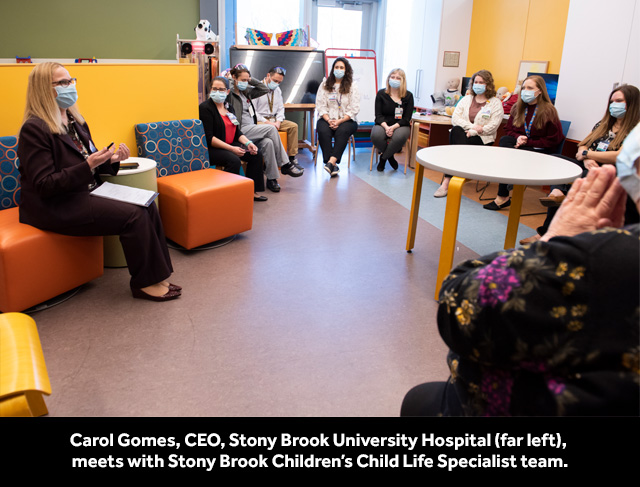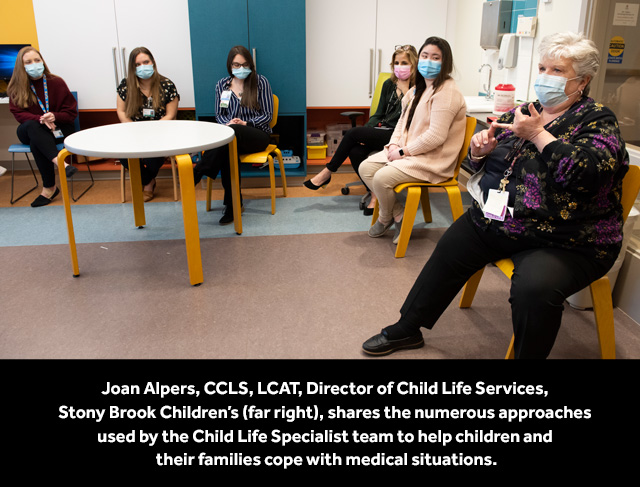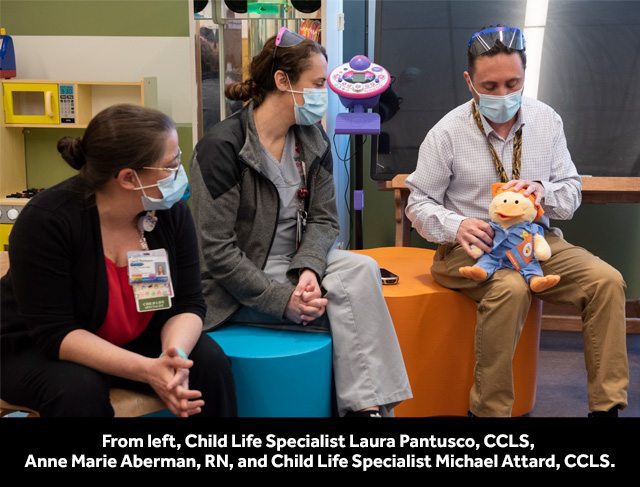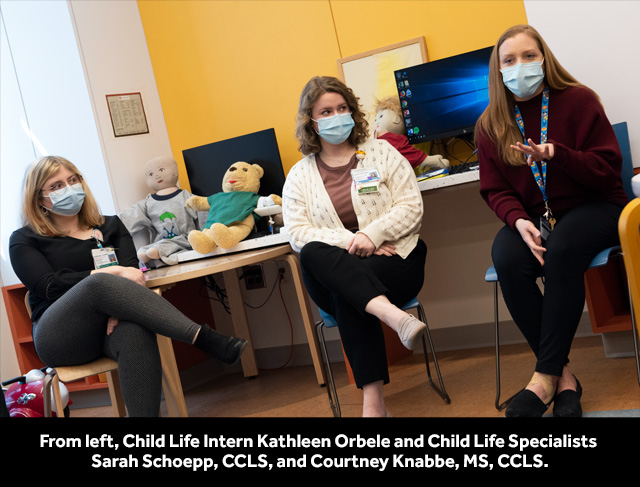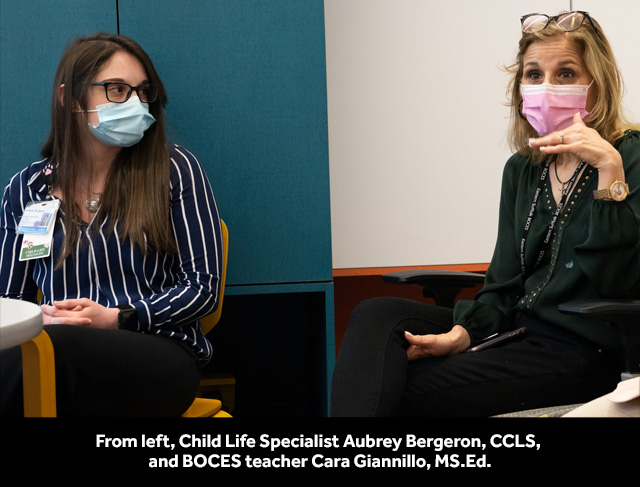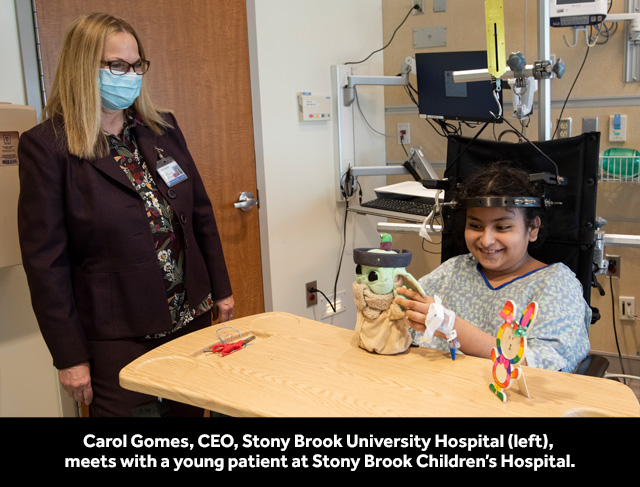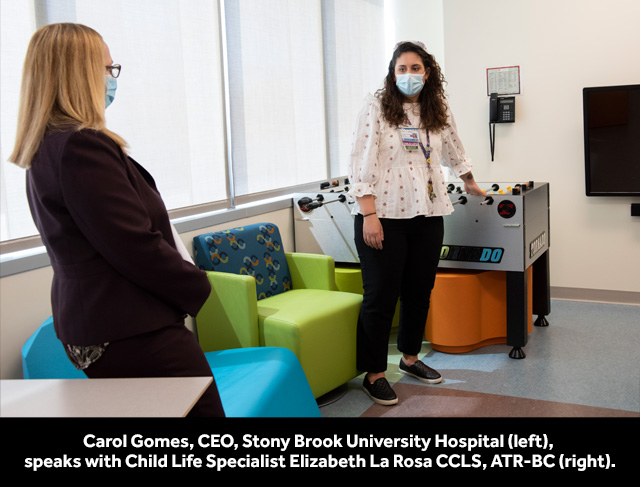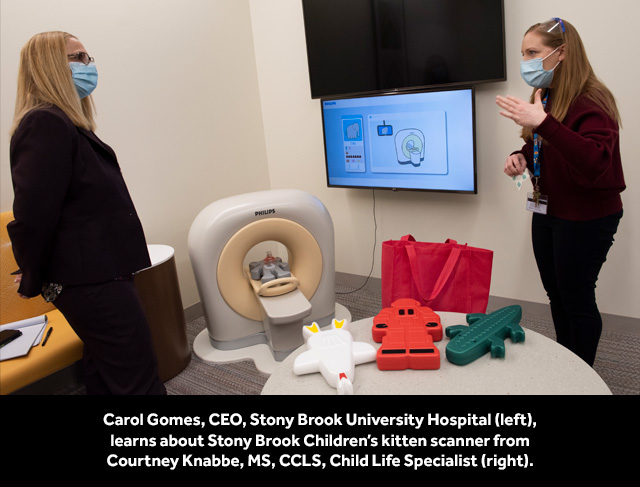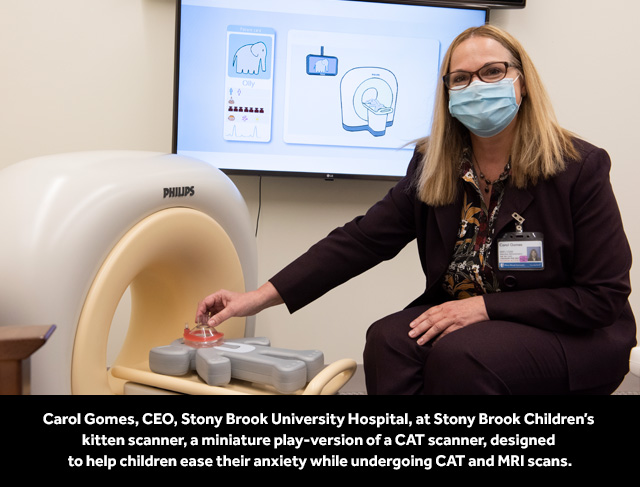Joan Alpers, a Certified Child Life Specialist (CCLS) and Licensed Creative Arts Therapist (LCAT) in New York State, noted that the importance of using “play” to provide support for children assists in managing emotional stress by developing and implementing age-appropriate strategies to minimize trauma and enhance understanding of medical diagnoses. Joan also shared the numerous approaches used by our Child Life Specialist team to help children and their families cope with medical situations. Pet therapy, art therapy, music therapy, “medical-play” and preparation for procedures are a few pathways used to support these efforts and provide a sense of mastery for children who are challenged by illness and hospitalization.
Laura Pantusco, CCLS, works in the Emergency Department with the medical team, including Anne Marie Aberman, T & R Ctr Nurse III, to create an experience on the front end of a potential hospital stay for children and parents. They use diversionary activities, such as the use of headsets, iPads and singing songs to interact with children, providing a non-threatening environment. The team is encouraged to use play in practice, which bolsters support and optimizes the hospital experience for the entire family.
Mike Attard, CCLS, completed his child life internship at Stony Brook in 2002, has worked at other hospitals and rejoined Stony Brook Children’s. He expressed how he has watched the growth of the department from a small playroom to an exploding phenomenon, which permeates the essence of the Stony Brook Children’s. Mike further described how he becomes involved with pediatric intensive care and pediatric oncology patients when they first learn their diagnosis, and demonstrated how the team works through the process with families, including siblings. He noted the importance of working with other disciplines, including but not limited to attending physicians, nurses and social workers, indicating that “it takes a village.”
For our pediatric oncology patients, the team shared the “chemo duck,” which is a teaching tool used to explain how ports work, and allows patients to understand what it means to be diagnosed with cancer. It is a safe place for patients to express themselves. The use of “surgi-dolls” allows the team to describe IV use and other procedures to prepare our young patients for surgery. These activities provide coping skills, and the use of medical play lessens the anxiety level before such procedures.
Liz La Rosa, CCLS, ATR-BC, spoke about the work being accomplished on inpatient acute units, working with Sarah Schoepp, CCLS. They spoke about the collaborative achievements associated with art therapy to make connections and provide a sense of emotional expression. Liz is dual certified in art therapy and child life.
The ability for children to interact with Child Life Specialists also allows for smooth transitions between units and procedural areas. Art therapy intern Joy Blazofsky uses art materials to provide a normalized, safe environment to process difficult information. In pediatric special procedures, home of the “kitten scanner,” there is an opportunity for children to better understand how scans are used to see inside their bodies. Courtney Knabbe, CCLS, helps by offering children toy goggles and an application that mimics the sound of an MRI scanner. These playful activities prepare children using all five senses before procedures and diagnostic testing. The use of play preparation and the MRI VRI, a video device that can play movies during an MRI, has proven to decrease sedation rates while increasing cooperation during testing.
Aubrey Bergeron, CCLS, described working with anesthesiologists and surgeons to support children and families to become more comfortable with surgery preparation. She often walks to the operating room with the family, allowing parents to be with their child until sedation occurs.
Anna Izquierdo, CCLS, started in the department last September and works closely with endoscopy to prepare children for anesthesia. The use of masks, IVs and equally important, prepares parents as well. She also assists to cover other pediatric services, including oncology, ambulatory surgery and the Emergency Department.
Lauren Sharaby, CCLS, was unable to join the gathering when I visited with the team. Her team shared her work in helping outpatient children and their families in the Hematology Oncology clinic, making the hard work of weekly visits, chemotherapy and long-term illness easier for children and families to endure.
The Child Life Specialists, similar to colleagues throughout the hospital, showed community support during the pandemic by drawing chalk illustrations on the walkways leading up to the hospital’s main entrances. This effort provided a sense of community, collaboration and team spirit to support our team and our patients.
Liz La Rosa’s first taste of Stony Brook Medicine was during her art therapy internship here. She noticed the closely knit nature of the team, the importance of teamwork and how everyone steps in to help each other during times of need. It was also noted that our interdisciplinary rounding processes and the Family Advisory Council are extremely active forums in which significant intellectual interfacing transpires.
All of the Child Life Specialists, including their leader, Joan Alpers, all reflected on the dedication, commitment and collaborative nature of this incredibly talented and compassionate team. Collectively, the team expressed enthusiasm and appreciation for the state-of-the-art facility that Stony Brook Children’s has become as the team continues to grow with the health system to provide an important and valuable service that contributes to the well-being of our pediatric patient population. This ray of sunlight in our organization clearly shone through in the level of commitment and care demonstrated in day-to-day activities at Stony Brook Children’s.
Carol


